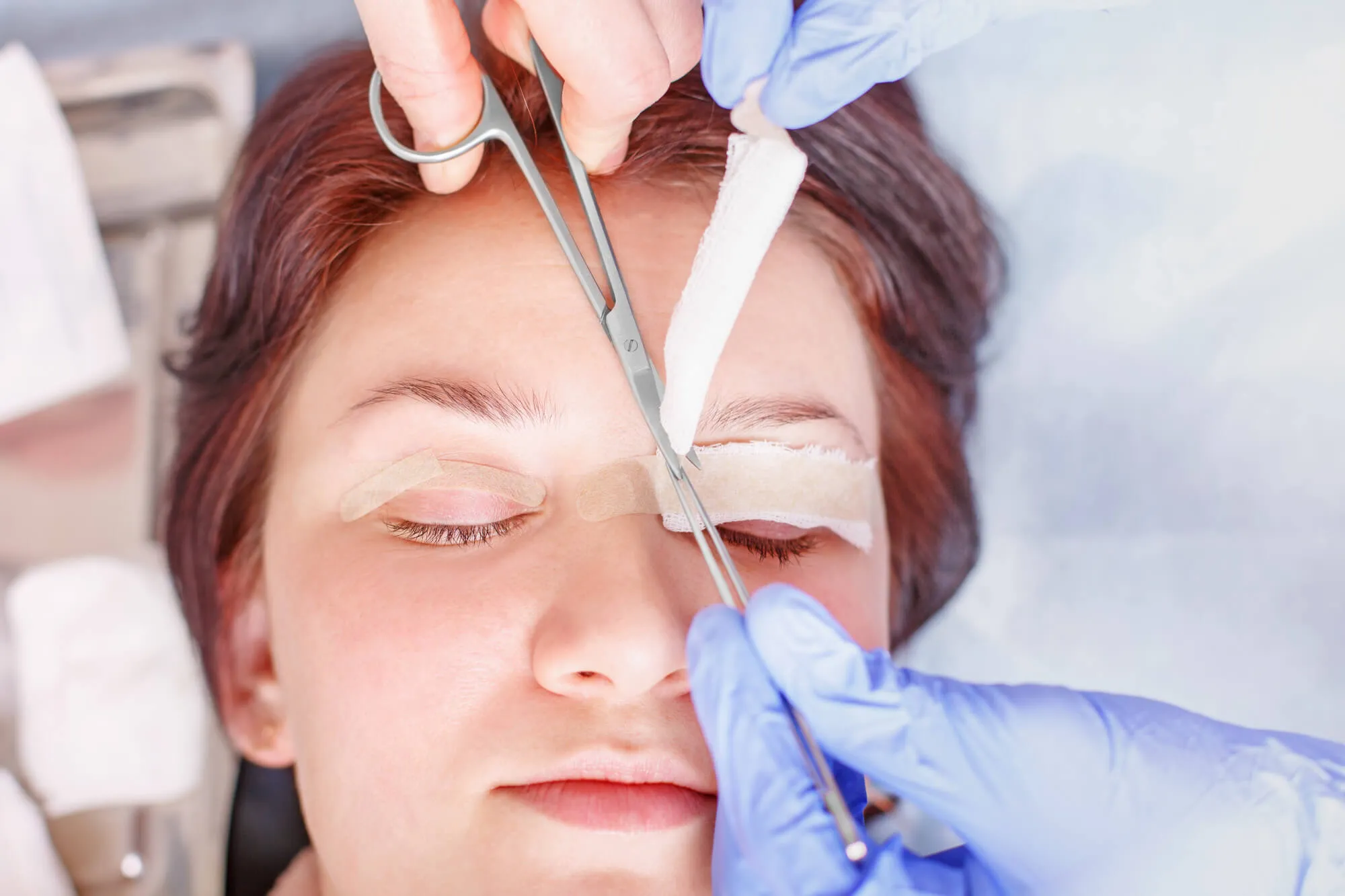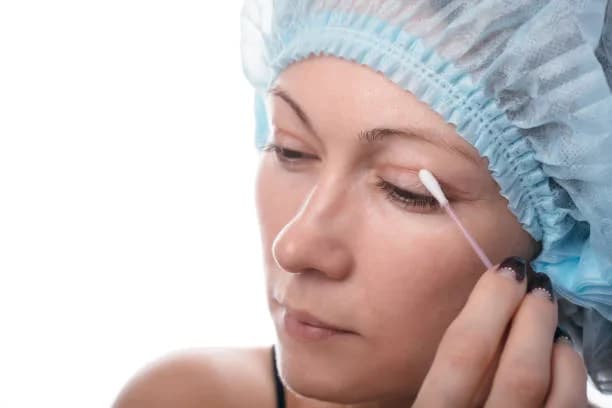Upper eyelid blepharoplasty is one of the most common procedures performed worldwide for both functional and cosmetic indications. An Upper Eyelid Lift or Upper Blepharoplasty is a specialist eyelid surgery procedure that removes the folds of loose skin and bulges of protruding fat that sit over the upper eyelids, to produce a less-tired and more youthful appearance. As a result of aging, gravity, and the skin losing its elasticity, the muscles around the eye weaken, and “eye bags” or a hooded appearance can be seen in the upper eyelid skin.
What are the treatment options for Eyelid Surgery?
An Upper Blepharoplasty is a surgical procedure carried out, under local anesthetic, by a plastic surgeon. An upper blepharoplasty may be indicated for functional reasons:
Excess laxity with temporal hooding may cause patients to constantly have to raise their brows or chin to see. Some even have trouble driving and seeing traffic lights.
Constant use of the frontalis muscle in the presence of dermatochalasis and ptosis may give rise to frontal headaches.
Eye irritation may be caused by eyelash ptosis or entropion because of dermatochalasis.
Skin-on-skin irritation may cause dermatitis
Down-gaze ptosis is the drop of the upper eyelids that occurs because of the redundant upper eyelid skin and interferes with reading.

What is an upper eyelid blepharoplasty?
An upper eyelid blepharoplasty is a type of eye surgery primarily used to lift and remove excess skin and other tissues from the upper eyelid due to vision or cosmetic concerns. As we age, our eyelids stretch, and the muscles supporting them weaken, leading to excess skin and fat gathering above and below our eyelids. This can cause sagging eyebrows, droopy upper lids, and bags under the eyes.
The purpose of an upper eyelid blepharoplasty is to treat sagging tissues along the eyelid area. You might consider this surgery for aesthetic reasons or if your eyelids feel heavy and are bothersome. This surgery may also treat mechanical ptosis, a condition where the eyelids droop down because of the weight of excess skin and bulging fat pads that can interfere with your vision. You might also be interested in this procedure if you have frequent dermatitis from skin friction.
During the procedure, a surgeon will inject a local anesthetic into your eyelid to numb the area. In some cases, a general anesthetic may be used. During an upper blepharoplasty, a surgeon makes incisions along the eyelid crease so they can then peel back excess skin and remove bulging fatty tissues. Any loose skin is removed before a surgeon reshapes the eyelid and closes the incision. Sutures may be needed to close the incision. The procedure may take up to 2 hours to complete.
What’s the purpose of an upper-eye blepharoplasty?
An upper-eye blepharoplasty is a surgical procedure that primarily aims to address issues related to the upper eyelid. The main purpose of this surgery is to treat sagging tissues along the eyelid area. This condition often arises as a result of aging, where the eyelids stretch and the muscles supporting them weaken. Consequently, excess skin and fat can accumulate above and below the eyelids, leading to sagging eyebrows, droopy upper lids, and bags under the eyes.
You might consider this surgery for either aesthetic reasons or if your eyelids feel heavy and are bothersome. It is particularly beneficial for those who experience mechanical ptosis, a condition where the eyelids droop down due to the weight of excess skin and bulging fat pads, which can interfere with vision. Additionally, individuals who frequently suffer from dermatitis due to skin friction may also find this procedure beneficial.
The procedure is not only about enhancing one’s appearance but also about improving the quality of life. For instance, by removing the excess skin and fat from the upper eyelids, the surgery can significantly improve peripheral vision, which is often compromised in individuals with severe drooping of the upper eyelids. This can make daily activities such as reading and driving easier and safer.
Cosmetic upper eyelid blepharoplasty steps
Upper eyelid blepharoplasty, depending on its complexity, can be performed in the operating room or the office. Surgery is typically performed with minimal sedation or with local injections of anesthetics. After the injection of local anesthetics, a fine scalpel and electrocautery are used to precisely remove the redundant skin. Just enough skin will be removed to give you the natural-appearing and youthful look you desire but not too much to the extent that eyelid closure (and thus the eye) is compromised. After ensuring symmetry between both eyes, the skin will be closed with sutures.
Cosmetic eyelid surgery risks
Minor side effects associated with blepharoplasty include temporary blurry or double vision, temporary swelling or bruising, and tiny bumps along the incision. More serious risks include asymmetry, dry eyes, or difficulty closing the eyes. However, the more qualified and experienced your doctor is in eyelid surgery, the lower that risk. Permanent blindness and double vision are exceedingly uncommon and rarely do they happen in experienced hands.

Vision after a cosmetic blepharoplasty
Following your blepharoplasty, your vision may be temporarily blurry due to minor corneal swelling and the use of eye lubricants that we provide. However, your vision will recover fully in a few days. There will be no patches that will completely cover your eyes following surgery.
Cosmetic upper eyelid blepharoplasty results
Although results vary from patient to patient, you should expect to see brighter, tighter, and more open eyes after cosmetic upper eyelid blepharoplasty. The results can be subtle but impactful. You should look natural, yet more alert and rested, more youthful, and more vibrant. While many patients return to work within 1 to 2 weeks after blepharoplasty, it may take several weeks for your swelling to subside completely. You should be able to see your final results from cosmetic eyelid surgery in about 4 to 6 weeks following your surgery.

Are the results of cosmetic blepharoplasty permanent?
The results of cosmetic blepharoplasty are designed to be long-lasting. Nevertheless, over time, the elasticity of your skin and the quality of your underlying facial muscles will continue to change in response to aging and other environmental factors.
Upper blepharoplasty Recovery
The recovery process after an upper blepharoplasty is generally straightforward, but it can vary depending on the patient’s general health, pain tolerance, and the surgical technique performed. On average, recovery after blepharoplasty takes about 10 days, with the final results emerging within 4 months after the surgery.
Immediately after the surgery, patients may experience blurry vision due to the thick antibiotic ointment used on the eyes during the procedure. This ointment is typically continued for about a week post-surgery. Common postoperative side effects include watery eyes, dry eyes, swelling, and bruising. To address these issues, the surgeon may prescribe eye drops for dryness, and patients can use ice to help mitigate swelling 24-48 hours after the surgery.
Patients are provided with specific aftercare instructions to ensure proper healing. These instructions often include using prescription ointment as directed, avoiding strenuous activities, and taking time off work. It’s also recommended to prepare as much as possible in advance, such as pre-cooking meals, stocking up the pantry, filling prescriptions, and arranging assistance with children or pets.
The most serious bruising and swelling occur during the first week after surgery. If the surgeon didn’t use dissolvable sutures, a follow-up visit is scheduled after one week to remove them. Stitches from the upper eyelid skin incision will ordinarily be removed 5 days after your surgery.
Conclusion
In conclusion, an upper blepharoplasty is a transformative surgical procedure that addresses both functional and aesthetic concerns related to the upper eyelid. It serves a dual purpose of improving vision by removing excess skin and fat that may obstruct vision and enhancing one’s appearance by treating sagging and drooping eyelids. The procedure is relatively straightforward and is performed under local or general anesthesia. While the recovery process can involve some discomfort, such as swelling and bruising, these side effects are typically temporary and can be managed effectively with appropriate aftercare. Ultimately, an upper blepharoplasty can significantly improve a patient’s quality of life, boosting their self-confidence and satisfaction with their appearance. As with any surgical procedure, it’s important for individuals considering an upper blepharoplasty to discuss their goals and expectations with a qualified healthcare provider to ensure the best possible outcome.
Read more: